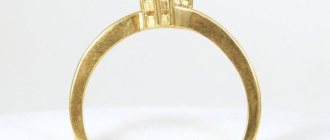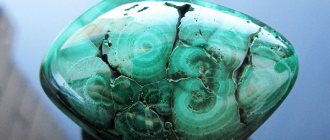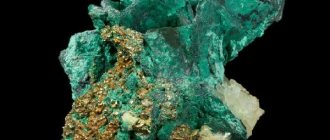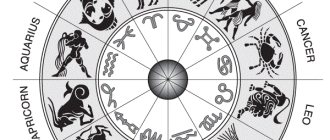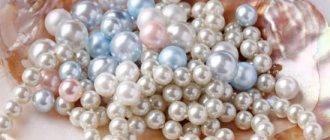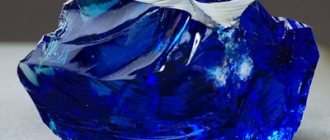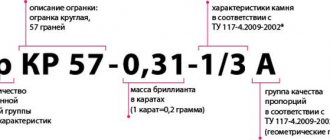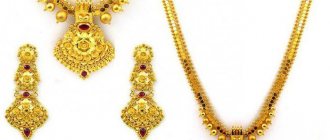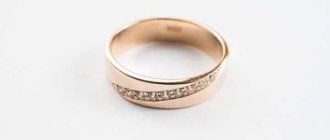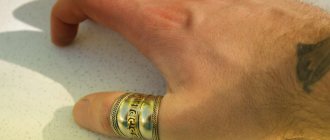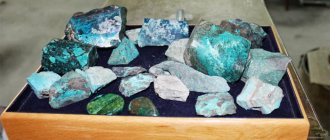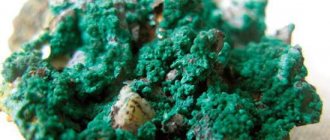| Category | Carbonates (minerals) |
| Title in English | Malachite |
| Formula | Cu2CO3(OH)2 |
| Group | Carbonate group |
| Color | Green |
| Stroke color | Green |
| Shine | Glass, Silky |
| Transparency | Translucent, Translucent |
| singonia | Monoclinic |
| Hardness | 3,5 — 4 |
| Cleavage | Perfect |
| Density, g/cm³ | 3,75 — 3,95 |
| Kink | Shellish, Splintered |
| origin of name | There are two versions of the origin of the name for this beautiful bright green mineral. In the first, they use the ancient Greek word “malakos”, which is translated into Russian as soft. And in the second, it was based on the name of the herbaceous plant Mallow, because it was considered that the color of the stone resembled the leaves of “malach” (mallow). |
Malachite is one of the first semi-precious minerals that people began to use. In ancient times, copper was obtained from it. The term “malachite” is translated differently from different languages: “green grass” or “soft”. In general, the name indicates the properties of this beautiful and valuable mineral.
Malachite deposits
The largest deposits of malachite are located in the Congo.
Samples from these deposits are distinguished by patterns in the form of small, regular-shaped rings. — Advertising —
Malachite is also mined in countries such as the USA, England, Namibia, Mexico, Russia, Australia and Kazakhstan.
Previously, Ural malachites were very famous and highly valued, but the mines, which were developed over four centuries, are now completely exhausted. After all, for example, in the 19th century, approximately 80 thousand tons of malachite were mined there annually. Also, it was in the Urals that giant malachite blocks weighing 250 and 100 tons were discovered.
History of malachite
The unusual properties of malachite were noticed by man a long time ago.
So, once, during a cholera epidemic in Egypt, people working in malachite mines were not harmed. After this, the stone began to be used as an amulet against diseases. Later they began to make green paint and eye shadow from it. But when using the latter, a person developed mental disorders over time. All this is due to the fact that malachite contains copper, which can accumulate in the human body with prolonged contact with the stone and cause harm. But for the ancient Egyptians, malachite symbolized the goddess Hathor, the patroness of life and birth. Malachite pendants were given to newborns and hung over cradles to protect the child from the evil spirit and the evil eye. The Romans believed that malachite was capable of giving a person mutual love.
— Advertising —
During the Middle Ages, malachite was considered a protector against the influence of black magicians. At the same time, people began to use malachite for decorating premises, creating jewelry and crafts. Now the Hermitage houses a collection of more than 200 malachite jewelry.
What species are found?
Geologists distinguish five types of mineral. They are distinguished by rich colors and a variety of patterns drawn by nature. The following varieties of malachite are known.
Tape (case). The stone is light green in color with a hint of turquoise and blue sky. Its entire surface is intertwined with striped patterns. It is the ribbon type that is most often used when creating jewelry.
Satin (velvet). The stone has a radiant structure, dark green color with a silky texture. The gem is not popular among jewelers due to the unexpressed patterns on the surface.
Radiant. The dark green pebble is covered all over with thin black lines.
Sinter kidney-shaped. Known for its vibrant interweaving of light and dark stripes. The boundaries between them are clear, there is no smooth transition.
Concentric-zonal. It features rich shades - from turquoise to bright emerald. The surface of the stone is intertwined with intricate patterns - concentric rings of different sizes.
They are twisted into curls and merge into one original pattern. The popular name for this species is “peacock eye.”
Reference samples are mined in the Urals. The concentric stone is prized by jewelers.
Physico-chemical characteristics of malachite
In terms of its chemical composition, malachite is the main copper carbonate, which contains impurities of silicon, phosphorus and calcium oxides.
The color of the stone can be found in both dark saturated green and light turquoise green. It is opaque, only small crystals show through. Has a matte, velvety shine. Dense kidney-shaped growths are characterized by a striped color.
The hardness of malachite on the Mohs scale is 3.5-4, density 3.9-4.1 g/cm3.
The crystals have a monoclinic system, needle-shaped or fine-prismatic shape. Dissolves in acids to form green solutions.
Malachite is found together with cuprites, chrysocolla, azurites, and copper phosphates. Its formation occurs through the interaction of solutions containing copper and carbonate rocks.
Magic stone that grants wishes
Speaking about the magical properties of malachite, it should be said that the stone has the ability to open the third eye of its owner. In general, many inexplicable and mysterious things are associated with this stone: for example, it is capable of making its owner invisible from people with bad energy and hostile intentions. They also firmly believed that if you drink water from a malachite bowl, you will have the ability to talk to animals.
What are the magical properties of malachite stone for women? This is a very powerful love talisman that can attract your other half. But here a woman needs to be careful, since the love magic of the stone is so strong that its ability to attract men can result in violence for the owner of the stone. It is recommended to make a silver frame for malachite, since this noble metal will somewhat weaken the influence of the mineral.
Malachite is a hydrous copper carbonate that has all shades of green: from the lightest turquoise to dark green
The gem is perfect for representatives of creative professions; it will be especially useful for artists, singers and musicians, because the stone is able to attract people's attention to its owner.
Helping a person find harmony with the world and tranquility, fulfilling his desires, protecting him from diseases and dangers - all these are also the magical properties of the stone, which give it popularity.
Types of malachite
Malachite is classified according to the nature of the patterns on its surface into looped, ribbon, cockade, patterned, and flowing malachite.
According to the quality of the stone, the following subtypes are distinguished:
- Turquoise is the highest quality grade with the hardest structure, best suited for jewelry processing.
- Velvet or fleece - has a high grain size, which makes it difficult to process.
- Curly is a beautiful rare species with patterns that resemble the movement of birch foliage in the wind.
Magical properties of malachite
Since ancient times, malachite has been considered a protective stone against diseases, the evil eye and troubles, especially effective for children and newborns.
The stone helps achieve physical and emotional harmony in its owner. Gives wisdom and spiritual strength. Malachite in a gold frame becomes a stone of good luck and success in all areas of life.
In India, the most valuable is azure-malachite, which is blue-green in color, which consists of malachite and azurite. It is believed that such a stone cleanses a person from fear, anxiety, resentment and all negative emotions.
What minerals can malachite mix with?
Depending on the metal replacing malachite, different types of malachite aggregates are also distinguished.
It can be replaced by minerals such as aurichalcite, cuprite, pseudomalachite, chrysocolla, and pseudomorphs of atacamite and native copper can also form with it:
- Aurichalcite is a mineral containing approximately 2.5 times more zinc than copper. Its color varies from light green to sky blue.
- Cuprite is also known as “red copper”, “brick ore”. Composed of more than 80% copper, it has bright red, pink, even lead-gray colors.
- Pseudomalachite is a hydrous copper phosphate, which got its name because of its similarity with malachite, also known as “false malachite.” Colored mainly in dark green, may have bluish tints. Varieties of pseudomalachite that have a higher density can be used as a substitute for malachite.
- Chrysocolla has a dense color and matte finish. Previously, it was called “malachite flint”. This mineral has a blue color with an admixture of green, shades from blue and gray to brown.
- Atacamite is quite rare. This mineral contains up to 60% copper and has a color of various green shades. Among the accompanying rocks are chrysocolla, cuprite, and azurite. Malachite often replaces atacamite and also forms pseudomorphs on it.
- Native copper is found with impurities of other metals - gold, silver, iron, but it can also be chemically pure. It is characterized by deposits of various colors, usually brown, green and black, which consist of oxides and bicarbonates of copper (cuprite, malachite and azurite).
Ornamental value
Malachite has great jewelry and ornamental value due to its rich color and beautiful sinuous pattern. It is rarely found in nature monochromatic and uniform, often rich in inclusions of various minerals, black additives of copper and resin ore, fibers and grains of chrysocolla, azurite and other rocks.
Such a stone is in no way considered defective; on the contrary, inclusions of other minerals only make it more decorative. Defects of malachite are usually considered to be its porosity and fracturing.
If earlier the Urals were famous as the main miner of malachite, now the mineral is mined mainly in Africa. Jewelers reverence local stones less than Ural stones, but they are still beautiful: they have concentric thin rings of regular shape, dark and light zones of the stone alternate in more contrast. This distinguishes them from Ural malachite, whose rings had an irregular shape.
Malachite is easy to process due to its malleable structure. It lends itself well to cutting, grinding and polishing. It is usually set in white metals, with which it looks especially beautiful.
Healing properties of malachite
Malachite is often called the “stone of health” and is used for asthma, rheumatism, toothache, poisoning and depression.
Modern lithotherapy recommends the use of malachite for the treatment of diseases of the heart and lungs, pancreas and spleen. The stone helps in tissue restoration, has a calming effect, and normalizes hormonal balance.
It is believed that the lighter the stone, the higher its healing properties.
According to American scientists, malachite is a good anti-radiation agent.
Malachite beads and pendants, as well as pyramids and balls, are used as medicinal products.
Applications of malachite
Malachite is used in the creation of jewelry, as well as various items for interior decoration, such as boxes and vases; it is also used to make inlays and perform finishing work. Malachite is widely used in lithotherapy, astrology and esotericism.
How to distinguish real malachite from a fake
Today, there are several ways to make counterfeits of malachite, namely:
- Based on malachite chips, which are compressed pieces of low-quality malachite with paint impurities. Such products crumble easily and give stains from artificial coloring.
- From glass. Glass is quite easy to paint green, but a similar example is easily distinguished by its transparency, as well as the absence of a unique pattern on the surface.
- Made of plastic. When heated or in contact with a hot needle, such an imitation begins to melt, which will never happen with a natural mineral.
- Rock. In order to distinguish a fake from another green stone, a drop of ammonia is applied to it. Real malachite turns blue. Under the influence of acids it begins to bubble, but such a test will irreversibly damage the natural sample.
Interesting facts about malachite
- The largest collection of malachite products in Russia was owned by Count Rumyantsev N.P. It is known that during the Patriotic War of 1812 Napoleon unsuccessfully tried to find it in order to take the collection to France.
- Russian craftsmen were able to develop their own technology for processing malachite, which is called “Russian mosaic”.
- Malachite is highly susceptible to acid attack. If you put it in ammonia, it will turn red.
- The most valuable type of malachite is mined in the African Republic of Congo. African malachite is distinguished by regular concentric rings.
- The most correct and detailed description of malachite was given not by a mineralogist, but by a French astronomer and traveler. His name was Jean Chappe d'Auteroche (French: Jean Chappe d'Auteroche)
It is curious that there are people who are ready to buy raw malachite in order to make original products from it. It should be remembered that, no matter how soft and “obedient” the mineral may be, processing it using an artisanal method without the use of special tools is a sure way to hopelessly ruin the true beauty of malachite.
How to care for malachite
As a delicate stone with low density and hardness, malachite is prone to cracking. For this reason, it is protected from shocks and other mechanical influences, as well as sudden temperature changes. When heated, malachite can melt.
Since malachite is soluble in acids and ammonia, products made from it are cleaned with cool water and a soft cloth.
Kitchen
This area in the apartment needs a particularly thoughtful design, since both the hostess and the family should feel comfortable and cozy in it. A malachite-colored kitchen is undoubtedly an original and interesting color scheme. Since green has many other shades, designers recommend playing with them, choosing the right combination.
Decorating a kitchen in this color scheme will be successful if you skillfully use some tips:
When the finishing has not yet begun, and you are just thinking through its features, you should first decide on the choice of furniture, countertops, and household appliances. Only after this should you decide where to place malachite accents.
Green is a beautiful color, but, like everything in our lives, it requires moderation. I want to use a wide variety of shades on every square centimeter, but this can completely ruin the interior. It should be remembered that bright shades should only be present on surfaces with a small area. But malachite-colored wallpaper is perfect for large walls, where they will reveal themselves the most.
If your kitchen faces south, then this shade of green will be a real find for it. It will also go well with emerald, jade and others where blue predominates.
The choice of color directly affects the style. Therefore, malachite, as well as other muted, deep shades, are the prerogative of classic, minimalist kitchens.
As with small bathrooms, small kitchens require careful consideration of color schemes. Light shades should completely dominate here. Imitation of green stone can make itself felt only with neat strokes. For example, white curtains and vertical horizontal stripes, a malachite apron and napkins.
Malachite and zodiac sign
Malachite is perfect for Leos, Taurus and Libra; it smoothes out their character and makes them kinder and more sincere.
For Libra, it serves as an assistant in developing creative potential and gaining self-confidence; it gives Taurus softness, and helps Leo to be more attentive and caring towards the people around them. Malachite is not energetically suitable for Virgo and Cancer.
Horoscope compatibility
As for the compatibility of the stone according to the horoscope, it has its own influence on each sign. For example, malachite and the zodiac sign Taurus suit each other perfectly. Confidence and calmness are what the representative of this earth sign needs, and the green color of malachite is able to give him this.
It will help Aries to pacify their stubbornness and aggression, giving them emotional stability and prudence.
For Geminis suffering from frequent insomnia, it will provide healthy and deep sleep, restore vitality, relieve tension and relieve envious people from the evil eye.
The mineral is capable of awakening the hidden abilities of clairvoyance in Scorpios, helping to attract interest, and ensuring personal and professional growth.
This is a very powerful love talisman that can attract your other half.
For Libra, who is always rushing about and doubting, the stone will stabilize their volatile mood and help them gain holistic thinking. For Libra women, the stone will give charm and the ability to persuade.
Sagittarius is one of the signs, along with Taurus, for whom malachite is most suitable. For active Sagittarius, it will increase the desire to learn new things and attract pleasant acquaintances and good events into their lives.
The gem is a stone of health for Capricorns: it will calm their nerves, normalize rest, and give them resilience to overcome life’s failures.
For Aquarius, malachite is a reliable protection against grief and groundless fears; it will restore balance, help you forget past grievances and protect you from new ones. A green amulet will become a source of spiritual knowledge for this sign.
For Pisces, he prepared answers to questions that they always have a lot of. But malachite attracts increased attention to Pisces, which can negatively affect their emotional state.
He will help Leos curb their pride and look at others not from the position of a predator, but behave peacefully and kindly.
Only two signs are not recommended to contact malachite: Virgo and Cancer. Cancer is unable to understand all the energy of this mysterious green mineral - the stone simply will not open up to it. And he can deprive Virgos of calm, clarity of judgment and peace of mind.
